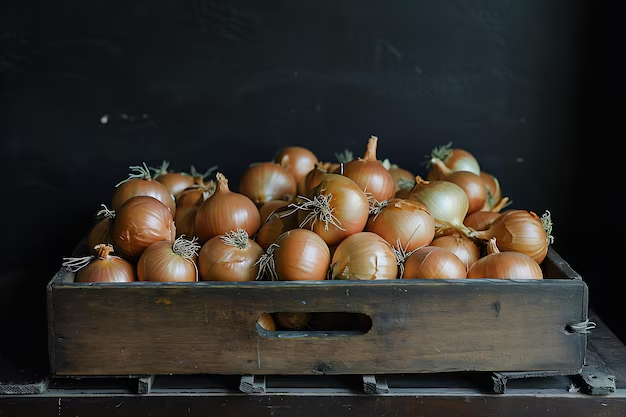Keeping Cut Onions Fresh Without a Fridge: Proven Techniques You Need to Know
Imagine chopping some onions for your favorite recipe and realizing you have more leftovers than anticipated. With limited refrigerator space or even no access to one, the question becomes: How do you preserve these cut onions without refrigeration? Fear not, there are reliable methods to ensure these crisp, flavorful additions stay fresh and ready for your cooking adventures.
🌱 Why Preserving Cut Onions Matters
Onions serve as a staple ingredient in various cuisines, adding depth and flavor to countless dishes. However, once an onion is cut, it quickly loses moisture and flavor and can spoil if not stored properly. Keeping onions fresh not only reduces waste but also ensures you always have quality ingredients on hand for your meals.
Drying Methods to Keep Onions
🤲 Traditional Air-Drying
Air-drying is an age-old technique that can prevent cut onions from spoilage by reducing their moisture content.
Preparation: Start by ensuring the onion slices are evenly cut. Smaller pieces will dry faster. Lay the onion slices on a clean, dry surface, preferably in a single layer.
Set-Up: Place the onions in a well-ventilated, dry area away from direct sunlight. Good airflow is crucial, so a mesh sieve or a baking rack can be useful.
Duration: This process can take several days, depending on the humidity and airflow. The goal is to achieve a leathery texture that indicates reduced moisture and a longer shelf-life.
🔆 Sun-Drying for Efficiency
While more dependent on your local weather conditions, sun-drying is a natural and effective way to preserve onions.
Indoor/Outdoor Setup: Whether indoors near a sunny window or outdoors, arrange onions on a drying rack covered with a thin cloth to protect from insects.
Turn Regularly: Rotate slices every few hours to dry evenly and check daily to avoid over-drying, which can lead to brittleness.
Storing Onions in a Cool, Dark Place
🍂 Using an Onion Bag or Net
An onion bag or net, often made from breathable material, can facilitate air circulation around the onions.
Storage: After drying, place your onions in the bag and hang them in a cool, dry, and dark place. A pantry or cellar is ideal.
Check Regularly: Inspect weekly to ensure no mold or rot develops, replacing any compromised onions immediately.
🏺 Earthenware Pots
Traditional in many cultures, earthenware pots can maintain a stable environment conducive to storing onions.
Layer with Ash or Sand: Inside the pot, layer the onion pieces with dry ash or sand, which absorbs moisture and keeps pests away.
Positioning: Place the pot in a corner where temperature fluctuations are minimal for optimal results.
Pickling: A Flavorful Preservation Method
🧂 Creating Quick Pickles
Pickling not only preserves onions but also enhances their flavor.
Simple Brine: Combine vinegar, water, salt, and sugar in equal parts, and bring to a boil.
Preparation: Place onions in a sterilized jar, pour the hot brine over them, and seal tightly.
Storage: After cooling, store in a pantry or cupboard. Pickled onions should last several weeks.
🥒 Adding Spices and Flavor
Customizing your pickled onions with spices can create exciting variations.
Spices to Try: Bay leaves, peppercorns, mustard seeds, or chili flakes are popular additions.
Experiment: Vary the vinegar type (apple cider, white wine) to explore different flavor profiles.
Dehydration for Longevity
🌞 Solar Dehydration
Solar dehydration combines sun-drying with controlled conditions to expedite the process.
Solar Dehydrator: Use a simple DIY or purchased solar dehydrator, ensuring it has adequate ventilation and consistent access to sunlight.
Monitor Moisture: Check the onions frequently to prevent over-drying.
🍽️ Utilizing a Heat Source
If sunlight is limited, a small heat source like a stove or campfire can aid dehydration.
Low, Consistent Heat: Keep onions near a warm (not hot) surface to gently reduce moisture.
Turn Regularly: To dry evenly and prevent scorching.
Preservation Through Creative Techniques
🌿 Herbs and Onions
Pairing onions with herbs can add another level of preservation.
Herb Layering: Place fresh herbs like thyme or rosemary between onion layers in a breathable container to infuse flavor and deter pests.
Refresh Regularly: Replace herbs every week or so to maintain freshness.
🍞 Charcoal’s Role
Charcoal, with its moisture and odor-absorbing qualities, can protect onions.
Charcoal Setup: Place charcoal pieces in a breathable bag alongside onions to benefit from its drying properties.
Regular Checks: Ensure no odd odors or rot develop by routine inspection.
🌟 Key Takeaways for Preserving Onions
Here's a handy summary to quickly recall how you can preserve cut onions without the aid of a refrigerator:
- Drying Methods: Use air or sun-drying to reduce moisture.
- Optimal Storage: Employ onion bags, earthen pots, or charcoal measures.
- Pickling for Flavor: Use a vinegar brine with spices to pickle onions.
- Creative Techniques: Leverage herbs and low heat for prolonging shelf-life.
Incorporating these strategies can ensure your culinary stockpile always includes fresh-cut onions, ready to enrich your meals. Say goodbye to wasted produce and revel in the vibrant flavors and aromas that preserved onions bring to your kitchen creations. Whether you're interested in practicing traditional methods or seeking quick and easy solutions, preserving cut onions without refrigeration is achievable and rewarding.
